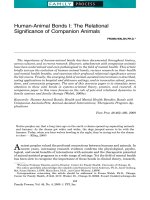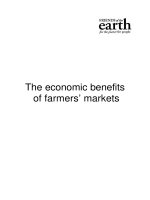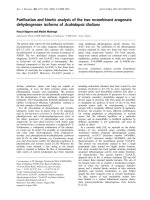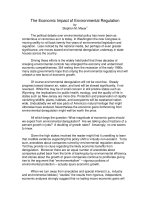Two Bits - The Cultural Significance of Free Software ppt
Bạn đang xem bản rút gọn của tài liệu. Xem và tải ngay bản đầy đủ của tài liệu tại đây (3.34 MB, 396 trang )
EXPERIMENTAL FUTURES
Technological Lives, Scientic Arts, Anthropological Voices
A series edited by Michael M. J. Fischer and Joseph Dumit
Two Bits
2008 duke university press durham and london
2008 duke university press durham and london
TH E C U LT URA L
SI G NI F IC ANC E O F
FR E E SOF TWA RE
Two Bits
CH R IS TOP HER M . K E LT Y
© 2008 Duke University Press
Printed in the United States of America on acid-free paper ∞
Designed by C. H. Westmoreland
Typeset in Charis (an Open Source font) by Achorn International
Library of Congress Cataloging-in-Publication data and republication acknowledg-
ments appear on the last printed pages of this book.
Licensed under the Creative Commons Attribution-NonCommercial-Share Alike Li-
cense, available at or by mail
from Creative Commons, 559 Nathan Abbott Way, Stanford, Calif. 94305, U.S.A.
“NonCommercial” as dened in this license specically excludes any sale of this
work or any portion thereof for money, even if sale does not result in a prot by the
seller or if the sale is by a 501(c)(3) nonprot or NGO.
Duke University Press gratefully acknowledges the support of HASTAC (Humani-
ties, Arts, Science, and Technology Advanced Collaboratory), which provided funds
to help support the electronic interface of this book.
Two Bits is accessible on the Web at twobits.net.
To my parents, Anne and Ted
Contents
Preface ix
Acknowledgments xiii
Introduction 1
Part I the internet
1. Geeks and Recursive Publics 27
2. Protestant Reformers, Polymaths, Transhumanists 64
Part II free software
3. The Movement 97
4. Sharing Source Code 118
5. Conceiving Open Systems 143
6. Writing Copyright Licenses 179
7. Coordinating Collaborations 210
Part III modulations
8. “If We Succeed, We Will Disappear” 243
9. Reuse, Modication, and the Nonexistence of Norms 269
Conclusion: The Cultural Consequences of Free Software 301
Notes 311
Bibliography 349
Index 367
Preface
This is a book about Free Software, also known as Open Source
Software, and is meant for anyone who wants to understand the
cultural signicance of Free Software. Two Bits explains how Free
Software works and how it emerged in tandem with the Internet as
both a technical and a social form. Understanding Free Software in
detail is the best way to understand many contentious and confus-
ing changes related to the Internet, to “commons,” to software, and
to networks. Whether you think rst of e-mail, Napster, Wikipedia,
MySpace, or Flickr; whether you think of the proliferation of da-
tabases, identity thieves, and privacy concerns; whether you think
of traditional knowledge, patents on genes, the death of scholarly
publishing, or compulsory licensing of AIDS medicine; whether
you think of MoveOn.org or net neutrality or YouTube—the issues
raised by these phenomena can be better understood by looking
carefully at the emergence of Free Software.
Why? Because it is in Free Software and its history that the is-
sues raised—from intellectual property and piracy to online po-
litical advocacy and “social” software—were rst gured out and
confronted. Free Software’s roots stretch back to the 1970s and
crisscross the histories of the personal computer and the Internet,
the peaks and troughs of the information-technology and software
industries, the transformation of intellectual property law, the in-
novation of organizations and “virtual” collaboration, and the rise
of networked social movements. Free Software does not explain
why these various changes have occurred, but rather how indi-
viduals and groups are responding: by creating new things, new
practices, and new forms of life. It is these practices and forms of
life—not the software itself—that are most signicant, and they
have in turn served as templates that others can use and transform:
practices of sharing source code, conceptualizing openness, writing
copyright (and copyleft) licenses, coordinating collaboration, and
proselytizing for all of the above. There are explanations aplenty
for why things are the way they are: it’s globalization, it’s the net-
work society, it’s an ideology of transparency, it’s the virtualization
of work, it’s the new at earth, it’s Empire. We are drowning in the
why, both popular and scholarly, but starving for the how.
Understanding how Free Software works is not just an academic
pursuit but an experience that transforms the lives and work of
participants involved. Over the last decade, in eldwork with soft-
ware programmers, lawyers, entrepreneurs, artists, activists, and
other geeks I have repeatedly observed that understanding how
Free Software works results in a revelation. People—even (or, per-
haps, especially) those who do not consider themselves program-
mers, hackers, geeks, or technophiles—come out of the experience
with something like religion, because Free Software is all about the
practices, not about the ideologies and goals that swirl on its sur-
face. Free Software and its creators and users are not, as a group,
antimarket or anticommercial; they are not, as a group, anti–
intellectual property or antigovernment; they are not, as a group,
pro- or anti- anything. In fact, they are not really a group at all:
not a corporation or an organization; not an NGO or a government
agency; not a professional society or an informal horde of hackers;
not a movement or a research project.
Free Software is, however, public; it is about making things pub-
lic. This fact is key to comprehending its cultural signicance, its
x
preface
appeal, and its proliferation. Free Software is public in a particu-
lar way: it is a self-determining, collective, politically independent
mode of creating very complex technical objects that are made pub-
licly and freely available to everyone—a “commons,” in common
parlance. It is a practice of working through the promises of equal-
ity, fairness, justice, reason, and argument in a domain of techni-
cally complex software and networks, and in a context of powerful,
lopsided laws about intellectual property. The fact that something
public in this grand sense emerges out of practices so seemingly ar-
cane is why the rst urge of many converts is to ask: how can Free
Software be “ported” to other aspects of life, such as movies, music,
science or medicine, civil society, and education? It is this prosely-
tizing urge and the ease with which the practices are spread that
make up the cultural signicance of Free Software. For better or for
worse, we may all be using Free Software before we know it.
xi
preface
Acknowledgments
Anthropology is dependent on strangers who become friends and
colleagues—strangers who contribute the very essence of the work.
In my case, these strangers are also hyperaware of issues of credit,
reputation, acknowledgment, reuse, and modication of ideas and
things. Therefore, the list is extensive and detailed.
Sean Doyle and Adrian Gropper opened the doors to this project,
providing unparalleled insight, hospitality, challenge, and curios-
ity. Axel Roch introduced me to Volker Grassmuck, and to much
else. Volker Grassmuck introduced me to Berlin’s Free Software
world and invited me to participate in the Wizards of OS confer-
ences. Udhay Shankar introduced me to almost everyone I know,
sometimes after the fact. Shiv Sastry helped me nd lodging in
Bangalore at his Aunt Anasuya Sastry’s house, which is called “Sili-
con Valley” and which was truly a lovely place to stay. Bharath
Chari and Ram Sundaram let me haunt their oce and cat-5 cables
during one of the more turbulent periods of their careers. Glenn
Otis Brown visited, drank, talked, invited, challenged, entertained,
chided, encouraged, drove, was driven, and gave and received ad-
vice. Ross Reedstrom welcomed me to the Rice Linux Users’ Group
and to Connexions. Brent Hendricks did yeoman’s work, suer-
ing my questions and intrusions. Geneva Henry, Jenn Drummond,
Chuck Bearden, Kathy Fletcher, Manpreet Kaur, Mark Husband,
Max Starkenberg, Elvena Mayo, Joey King, and Joel Thierstein
have been welcoming and enthusiastic at every meeting. Sid Burris
has challenged and respected my work, which has been an honor.
Rich Baraniuk listens to everything I say, for better or for worse; he
is a magnicent collaborator and friend.
James Boyle has been constantly supportive, for what feels like
very little return on investment. Very few people get to read and
critique and help reshape the argument and structure of a book,
and to appear in it as well. Mario Biagioli helped me see the intri-
cate strategy described in chapter 6. Stefan Helmreich read early
drafts and transformed my thinking about networks. Manuel De-
Landa explained the term assemblage to me. James Faubion cor-
rected my thinking in chapter 2, helped me immeasurably with the
Protestants, and has been an exquisitely supportive colleague and
department chair. Mazyar Lotfalian and Melissa Cefkin provided
their apartment and library, in which I wrote large parts of chapter
1. Matt Price and Michelle Murphy have listened patiently to me
construct and reconstruct versions of this book for at least six years.
Tom and Elizabeth Landecker provided hospitality and stunningly
beautiful surroundings in which to rewrite parts of the book. Lisa
Gitelman read carefully and helped explain issues about documen-
tation and versioning that I discuss in chapter 4. Matt Ratto read
and commented on chapters 4–7, convinced me to drop a useless
distinction, and to clarify the conclusion to chapter 7. Shay David
provided strategic insights about openness from his own work and
pushed me to explain the point of recursive publics more clearly.
Biella Coleman has been a constant interlocutor on the issues in
this book—her contributions are too deep, too various, and too
thorough to detail. Her own work on Free Software and hackers
has been a constant sounding board and guide, and it has been
a pleasure to work together on our respective texts. Kim Fortun
helped me gure it all out.
xiv
acknowledgments
George Marcus hired me into a fantastic anthropology depart-
ment and has had immense faith in this project throughout its
lifetime. Paul Rabinow, Stephen Collier, and Andrew Lako have
provided an extremely valuable setting—the Anthropology of the
Contemporary Research Collaboratory—within which the argu-
ments of this book developed in ways they could not have as a
solitary project. Joe Dumit has encouraged and prodded and ques-
tioned and brainstormed and guided and inspired. Michael Fischer
is the best mentor and advisor ever. He has read everything, has
written much that precedes and shapes this work, and has been an
unwavering supporter and friend throughout.
Tish Stringer, Michael Powell, Valerie Olson, Ala Alazzeh, Lina
Dib, Angela Rivas, Anthony Potoczniak, Ayla Samli, Ebru Kayaalp,
Michael Kriz, Erkan Saka, Elise McCarthy, Elitza Ranova, Amanda
Randall, Kris Peterson, Laura Jones, Nahal Nacy, Andrea Frolic,
and Casey O’Donnell make my job rock. Scott McGill, Sarah El-
lenzweig, Stephen Collier, Carl Pearson, Dan Wallach, Tracy Volz,
Rich Doyle, Ussama Makdisi, Elora Shehabbudin, Michael Morrow,
Taryn Kinney, Gregory Kaplan, Jane Greenberg, Hajime Nakatani,
Kirsten Ostherr, Henning Schmidgen, Jason Danziger, Kayte Young,
Nicholas King, Jennifer Fishman, Paul Drueke, Roberta Bivins,
Sherri Roush, Stefan Timmermans, Laura Lark, and Susann Wilkin-
son either made Houston a wonderful place to be or provided an
opportunity to escape it. I am especially happy that Thom Chivens
has done both and more.
The Center for the Study of Cultures provided me with a Faculty
Fellowship in the fall of 2003, which allowed me to accomplish
much of the work in conceptualizing the book. The Harvard His-
tory of Science Department and the MIT Program in History, An-
thropology, and Social Studies of Science and Technology hosted
me in the spring of 2005, allowing me to write most of chapters
7, 8, and 9. Rice University has been extremely generous in all
respects, and a wonderful place to work. I’m most grateful for a
junior sabbatical that gave me the chance to complete much of
this book. John Homan graciously and generously allowed the
use of the domain name twobits.net, in support of Free Software.
Ken Wissoker, Courtney Berger, and the anonymous reviewers for
Duke University Press have made this a much, much better book
than when I started.
xv
acknowledgments
My parents, Ted and Anne, and my brother, Kevin, have always
been supportive and loving; though they claim to have no idea what
I do, I nonetheless owe my small success to their constant support.
Hannah Landecker has read and reread and rewritten every part of
this work; she has made it and me better, and I love her dearly for
it. Last, but not least, my new project, Ida Jane Kelty Landecker, is
much cuter and smarter and funnier than Two Bits, and I love her
for distracting me from it.
xvi
acknowledgments
Introduction
Around 1998 Free Software emerged from a happily subterranean
and obscure existence stretching back roughly twenty years. At the
very pinnacle of the dotcom boom, Free Software suddenly popu-
lated the pages of mainstream business journals, entered the strat-
egy and planning discussions of executives, confounded the radar
of political leaders and regulators around the globe, and permeated
the consciousness of a generation of technophile teenagers growing
up in the 1990s wondering how people ever lived without e-mail.
Free Software appeared to be something shocking, something that
economic history suggested could never exist: a practice of creat-
ing software—good software—that was privately owned, but freely
and publicly accessible. Free Software, as its ambiguous moniker
suggests, is both free from constraints and free of charge. Such
characteristics seem to violate economic logic and the principles of
private ownership and individual autonomy, yet there are tens of
2
introduction
millions of people creating this software and hundreds of millions
more using it. Why? Why now? And most important: how?
Free Software is a set of practices for the distributed collabora-
tive creation of software source code that is then made openly and
freely available through a clever, unconventional use of copyright
law.
1
But it is much more: Free Software exemplies a considerable
reorientation of knowledge and power in contemporary society—a
reorientation of power with respect to the creation, dissemination,
and authorization of knowledge in the era of the Internet. This book
is about the cultural signicance of Free Software, and by cultural
I mean much more than the exotic behavioral or sartorial traits of
software programmers, fascinating though they be. By culture, I
mean an ongoing experimental system, a space of modication and
modulation, of guring out and testing; culture is an experiment
that is hard to keep an eye on, one that changes quickly and some-
times starkly. Culture as an experimental system crosses economies
and governments, networked social spheres, and the infrastructure
of knowledge and power within which our world functions today—
or fails to. Free Software, as a cultural practice, weaves together a
surprising range of places, objects, and people; it contains patterns,
thresholds, and repetitions that are not simple or immediately obvi-
ous, either to the geeks who make Free Software or to those who
want to understand it. It is my goal in this book to reveal some of
those complex patterns and thresholds, both historically and an-
thropologically, and to explain not just what Free Software is but
also how it has emerged in the recent past and will continue to
change in the near future.
2
The signicance of Free Software extends far beyond the arcane
and detailed technical practices of software programmers and
“geeks” (as I refer to them herein). Since about 1998, the practices
and ideas of Free Software have extended into new realms of life
and creativity: from software to music and lm to science, engineer-
ing, and education; from national politics of intellectual property
to global debates about civil society; from UNIX to Mac OS X and
Windows; from medical records and databases to international dis-
ease monitoring and synthetic biology; from Open Source to open
access. Free Software is no longer only about software—it exempli-
es a more general reorientation of power and knowledge.
The terms Free Software and Open Source don’t quite capture the
extent of this reorientation or their own cultural signicance. They
3
introduction
refer, quite narrowly, to the practice of creating software—an ac-
tivity many people consider to be quite far from their experience.
However, creating Free Software is more than that: it includes a
unique combination of more familiar practices that range from
creating and policing intellectual property to arguing about the
meaning of “openness” to organizing and coordinating people and
machines across locales and time zones. Taken together, these prac-
tices make Free Software distinct, signicant, and meaningful both
to those who create it and to those who take the time to understand
how it comes into being.
In order to analyze and illustrate the more general cultural sig-
nicance of Free Software and its consequences, I introduce the
concept of a “recursive public.” A recursive public is a public that is
vitally concerned with the material and practical maintenance and modi-
cation of the technical, legal, practical, and conceptual means of its
own existence as a public; it is a collective independent of other forms of
constituted power and is capable of speaking to existing forms of power
through the production of actually existing alternatives. Free Software
is one instance of this concept, both as it has emerged in the recent
past and as it undergoes transformation and dierentiation in the
near future. There are other instances, including those that emerge
from the practices of Free Software, such as Creative Commons,
the Connexions project, and the Open Access movement in science.
These latter instances may or may not be Free Software, or even
“software” projects per se, but they are connected through the same
practices, and what makes them signicant is that they may also
be “recursive publics” in the sense I explore in this book. Recursive
publics, and publics generally, dier from interest groups, corpora-
tions, unions, professions, churches, and other forms of organization
because of their focus on the radical technological modiability of
their own terms of existence. In any public there inevitably arises
a moment when the question of how things are said, who controls
the means of communication, or whether each and everyone is be-
ing properly heard becomes an issue. A legitimate public sphere is
one that gives outsiders a way in: they may or may not be heard,
but they do not have to appeal to any authority (inside or outside
the organization) in order to have a voice.
3
Such publics are not
inherently modiable, but are made so—and maintained—through
the practices of participants. It is possible for Free Software as we
know it to cease to be public, or to become just one more settled
4
introduction
form of power, but my focus is on the recent past and near future
of something that is (for the time being) public in a radical and
novel way.
The concept of a recursive public is not meant to apply to any and
every instance of a public—it is not a replacement for the concept
of a “public sphere”—but is intended rather to give readers a spe-
cic and detailed sense of the non-obvious, but persistent threads
that form the warp and weft of Free Software and to analyze simi-
lar and related projects that continue to emerge from it as novel
and unprecedented forms of publicity and political action.
At rst glance, the thread tying these projects together seems to
be the Internet. And indeed, the history and cultural signicance of
Free Software has been intricately mixed up with that of the Inter-
net over the last thirty years. The Internet is a unique platform—
an environment or an infrastructure—for Free Software. But the
Internet looks the way it does because of Free Software. Free Soft-
ware and the Internet are related like gure and ground or like
system and environment; neither are stable or unchanging in and of
themselves, and there are a number of practical, technical, and his-
torical places where the two are essentially indistinguishable. The
Internet is not itself a recursive public, but it is something vitally
important to that public, something about which such publics care
deeply and act to preserve. Throughout this book, I will return to
these three phenomena: the Internet, a heterogeneous and diverse,
though singular, infrastructure of technologies and uses; Free Soft-
ware, a very specic set of technical, legal, and social practices that
now require the Internet; and recursive publics, an analytic concept
intended to clarify the relation of the rst two.
Both the Internet and Free Software are historically specic, that
is, not just any old new media or information technology. But the In-
ternet is many, many specic things to many, many specic people.
As one reviewer of an early manuscript version of this book noted,
“For most people, the Internet is porn, stock quotes, Al Jazeera
clips of executions, Skype, seeing pictures of the grandkids, porn,
never having to buy another encyclopedia, MySpace, e-mail, online
housing listings, Amazon, Googling potential romantic interests,
etc. etc.” It is impossible to explain all of these things; the meaning
and signicance of the proliferation of digital pornography is a
very dierent concern than that of the fall of the print encyclopedia
5
introduction
and the rise of Wikipedia. Yet certain underlying practices relate
these diverse phenomena to one another and help explain why they
have occurred at this time and in this technical, legal, and social
context. By looking carefully at Free Software and its modulations,
I suggest, one can come to a better understanding of the changes
aecting pornography, Wikipedia, stock quotes, and many other
wonderful and terrifying things.
4
Two Bits has three parts. Part I of this book introduces the reader
to the concept of recursive publics by exploring the lives, works,
and discussions of an international community of geeks brought to-
gether by their shared interest in the Internet. Chapter 1 asks, in an
ethnographic voice, “Why do geeks associate with one another?”
The answer—told via the story of Napster in 2000 and the stan-
dards process at the heart of the Internet—is that they are making
a recursive public. Chapter 2 explores the words and attitudes of
geeks more closely, focusing on the strange stories they tell (about
the Protestant Reformation, about their practical everyday poly-
mathy, about progress and enlightenment), stories that make sense
of contemporary political economy in sometimes surprising ways.
Central to part I is an explication of the ways in which geeks argue
about technology but also argue with and through it, by building,
modifying, and maintaining the very software, networks, and legal
tools within which and by which they associate with one another.
It is meant to give the reader a kind of visceral sense of why certain
arrangements of technology, organization, and law—specically
that of the Internet and Free Software—are so vitally important to
these geeks.
Part II takes a step back from ethnographic engagement to ask,
“What is Free Software and why has it emerged at this point in
history?” Part II is a historically detailed portrait of the emergence
of Free Software beginning in 1998–99 and stretching back in time
as far as the late 1950s; it recapitulates part I by examining Free
Software as an exemplar of a recursive public. The ve chapters
in part II tell a coherent historical story, but each is focused on a
separate component of Free Software. The stories in these chapters
help distinguish the gure of Free Software from the ground of the
Internet. The diversity of technical practices, economic concerns,
information technologies, and legal and organizational practices
is huge, and these ve chapters distinguish and describe the spe-
cic practices in their historical contexts and settings: practices of
6
introduction
proselytizing and arguing, of sharing, porting, and forking source
code, of conceptualizing openness and open systems, of creating
Free Software copyright, and of coordinating people and source
code.
Part III returns to ethnographic engagement, analyzing two re-
lated projects inspired by Free Software which modulate one or
more of the ve components discussed in part II, that is, which take
the practices as developed in Free Software and experiment with
making something new and dierent. The two projects are Creative
Commons, a nonprot organization that creates copyright licenses,
and Connexions, a project to develop an online scholarly textbook
commons. By tracing the modulations of practices in detail, I ask,
“Are these projects still Free Software?” and “Are these projects still
recursive publics?” The answer to the rst questions reveals how
Free Software’s exible practices are inuencing specic forms of
practice far from software programming, while the answer to the
second question helps explain how Free Software, Creative Com-
mons, Connexions, and projects like them are all related, strategic
responses to the reorientation of power and knowledge. The conclu-
sion raises a series of questions intended to help scholars looking at
related phenomena.
Recursive Publics and the Reorientation of Power
and Knowledge
Governance and control of the creation and dissemination of knowl-
edge have changed considerably in the context of the Internet over
the last thirty years. Nearly all kinds of media are easier to produce,
publish, circulate, modify, mash-up, remix, or reuse. The number
of such creations, circulations, and borrowings has exploded, and
the tools of knowledge creation and circulation—software and
networks—have also become more and more pervasively available.
The results have also been explosive and include anxieties about
validity, quality, ownership and control, moral panics galore, and
new concerns about the shape and legitimacy of global “intellec-
tual property” systems. All of these concerns amount to a reorienta-
tion of knowledge and power that is incomplete and emergent, and
whose implications reach directly into the heart of the legitimacy,
certainty, reliability and especially the nality and temporality of
7
introduction
the knowledge and infrastructures we collectively create. It is a re-
orientation at once more specic and more general than the grand
diagnostic claims of an “information” or “network” society, or the
rise of knowledge work or knowledge-based economies; it is more
specic because it concerns precise and detailed technical and legal
practices, more general because it is a cultural reorientation, not
only an economic or legal one.
Free Software exemplies this reorientation; it is not simply a
technical pursuit but also the creation of a “public,” a collective
that asserts itself as a check on other constituted forms of power—
like states, the church, and corporations—but which remains inde-
pendent of these domains of power.
5
Free Software is a response to
this reorientation that has resulted in a novel form of democratic
political action, a means by which publics can be created and main-
tained in forms not at all familiar to us from the past. Free Software
is a public of a particular kind: a recursive public. Recursive publics
are publics concerned with the ability to build, control, modify, and
maintain the infrastructure that allows them to come into being in
the rst place and which, in turn, constitutes their everyday practi-
cal commitments and the identities of the participants as creative
and autonomous individuals. In the cases explored herein, that spe-
cic infrastructure includes the creation of the Internet itself, as
well as its associated tools and structures, such as Usenet, e-mail,
the World Wide Web (www), UNIX and UNIX-derived operating
systems, protocols, standards, and standards processes. For the last
thirty years, the Internet has been the subject of a contest in which
Free Software has been both a central combatant and an important
architect.
By calling Free Software a recursive public, I am doing two things:
rst, I am drawing attention to the democratic and political signi-
cance of Free Software and the Internet; and second, I am suggest-
ing that our current understanding (both academic and colloquial)
of what counts as a self-governing public, or even as “the public,”
is radically inadequate to understanding the contemporary reori-
entation of knowledge and power. The rst case is easy to make:
it is obvious that there is something political about Free Software,
but most casual observers assume, erroneously, that it is simply
an ideological stance and that it is anti–intellectual property or
technolibertarian. I hope to show how geeks do not start with ide-
ologies, but instead come to them through their involvement in the
8
introduction
practices of creating Free Software and its derivatives. To be sure,
there are ideologues aplenty, but there are far more people who
start out thinking of themselves as libertarians or liberators, but
who become something quite dierent through their participation
in Free Software.
The second case is more complex: why another contribution to
the debate about the public and public spheres? There are two
reasons I have found it necessary to invent, and to attempt to make
precise, the concept of a recursive public: the rst is to signal the
need to include within the spectrum of political activity the cre-
ation, modication, and maintenance of software, networks, and
legal documents. Coding, hacking, patching, sharing, compiling,
and modifying of software are forms of political action that now
routinely accompany familiar political forms of expression like
free speech, assembly, petition, and a free press. Such activities are
expressive in ways that conventional political theory and social
science do not recognize: they can both express and “implement”
ideas about the social and moral order of society. Software and
networks can express ideas in the conventional written sense as
well as create (express) infrastructures that allow ideas to circulate
in novel and unexpected ways. At an analytic level, the concept of
a recursive public is a way of insisting on the importance to public
debate of the unruly technical materiality of a political order, not
just the embodied discourse (however material) about that order.
Throughout this book, I raise the question of how Free Software
and the Internet are themselves a public, as well as what that pub-
lic actually makes, builds, and maintains.
The second reason I use the concept of a recursive public is that
conventional publics have been described as “self-grounding,” as
constituted only through discourse in the conventional sense of
speech, writing, and assembly.
6
Recursive publics are “recursive”
not only because of the “self-grounding” of commitments and iden-
tities but also because they are concerned with the depth or strata
of this self-grounding: the layers of technical and legal infrastruc-
ture which are necessary for, say, the Internet to exist as the infra-
structure of a public. Every act of self-grounding that constitutes a
public relies in turn on the existence of a medium or ground through
which communication is possible—whether face-to-face speech,
epistolary communication, or net-based assembly—and recursive
publics relentlessly question the status of these media, suggesting
9
introduction
that they, too, must be independent for a public to be authentic. At
each of these layers, technical and legal and organizational deci-
sions can aect whether or not the infrastructure will allow, or
even ensure, the continued existence of the recursive publics that
are concerned with it. Recursive publics’ independence from power
is not absolute; it is provisional and structured in response to the
historically constituted layering of power and control within the
infrastructures of computing and communication.
For instance, a very important aspect of the contemporary In-
ternet, and one that has been ercely disputed (recently under
the banner of “net neutrality”), is its singularity: there is only one
Internet. This was not an inevitable or a technically determined
outcome, but the result of a contest in which a series of decisions
were made about layers ranging from the very basic physical con-
guration of the Internet (packet-switched networks and routing
systems indierent to data types), to the standards and protocols
that make it work (e.g., TCP/IP or DNS), to the applications that
run on it (e-mail, www, ssh). The outcome of these decisions has
been to privilege the singularity of the Internet and to champion
its standardization, rather than to promote its fragmentation into
multiple incompatible networks. These same kinds of decisions are
routinely discussed, weighed, and programmed in the activity of
various Free Software projects, as well as its derivatives. They are,
I claim, decisions embedded in imaginations of order that are si-
multaneously moral and technical.
By contrast, governments, corporations, nongovernmental orga-
nizations (NGOs), and other institutions have plenty of reasons—
prot, security, control—to seek to fragment the Internet. But it is
the check on this power provided by recursive publics and espe-
cially the practices that now make up Free Software that has kept
the Internet whole to date. It is a check on power that is by no
means absolute, but is nonetheless rigorously and technically con-
cerned with its legitimacy and independence not only from state-
based forms of power and control, but from corporate, commercial,
and nongovernmental power as well. To the extent that the Internet
is public and extensible (including the capability of creating private
subnetworks), it is because of the practices discussed herein and
their culmination in a recursive public.
Recursive publics respond to governance by directly engaging in,
maintaining, and often modifying the infrastructure they seek, as a









